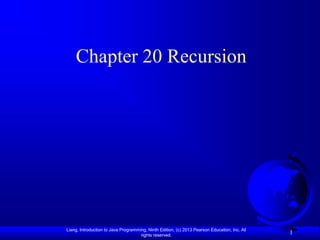The document discusses recursion and provides examples of using recursion to calculate factorials. It explains that recursion involves defining a problem in terms of smaller instances of the same problem until it reaches a base case. It provides step-by-step examples and animations tracing the recursive calculation of 4! to demonstrate how recursion works. It also discusses how recursive method calls are handled via a call stack in memory.


































![Recursive Implementation
/** Use binary search to find the key in the list */
public static int recursiveBinarySearch(int[] list, int key) {
int low = 0;
int high = list.length - 1;
return recursiveBinarySearch(list, key, low, high);
}
/** Use binary search to find the key in the list between
list[low] list[high] */
public static int recursiveBinarySearch(int[] list, int key,
int low, int high) {
if (low > high) // The list has been exhausted without a match
return -low - 1;
int mid = (low + high) / 2;
if (key < list[mid])
return recursiveBinarySearch(list, key, low, mid - 1);
else if (key == list[mid])
return mid;
else
return recursiveBinarySearch(list, key, mid + 1, high);
}
Liang, Introduction to Java Programming, Ninth Edition, (c) 2013 Pearson Education, Inc. All
rights reserved.
35](https://image.slidesharecdn.com/20slide-120813173044-phpapp01/85/JavaYDL20-35-320.jpg)
















